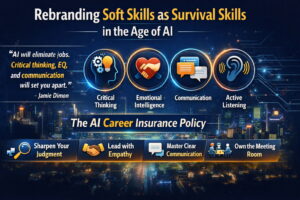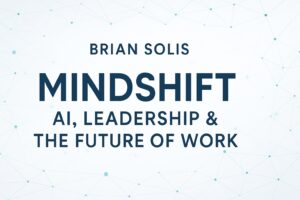
We all purport to be social media experts these days, yet most of us are truly students. Many of us overlook some of the most rudimentary elements that define and inspire the socialization of content, especially the social sciences involved with observing the culture, behavior, and conversations within online societies.
We’re excited, and maybe even obsessed, by the tools. We frantically rush from service to service in an exhausting attempt to keep up with our peers, fearing that we may one day relinquish our position as a leading authority on the subject of all things social. We are edglings, and the membership dues are paid in the form of time, attention, vision, and translation as we bring shiny new objects from the edge to the center.
But, are we losing sight of the guiding principles and teachings that foster meaningful and rewarding relationships simply because we’re practically held captive by a never-ending cycle of new and popular social tools? Our thinning attention may be clouding our ability to see the bigger picture.
Suddenly everyone is a social media consultant, yet very few of us are true online sociologists, observers, or genuine conversationalists. The firsthand research and lessons learned in the field are invaluable and definitely tier the experience and expertise of those selling their services. But, just because we’re on Twitter and Seesmic, blogging, or uploading video conferencing tools to YouTube doesn’t qualify us social media experts.
It’s so much more than the ability to guide companies on how to create fan pages on Facebook, islands on SecondLife, accounts on Pownce or Plurk, and profiles on Bebo or Myspace.
It’s the listening, charting social maps, drafting strategies for meaningful engagement, understanding our relevance in the short and long tail, and the definition of metrics and ROI that count for everything to businesses and respective decision makers these days.
– Traffic
– Links
– Trackbacks
– Comments
– Threads
– Registrations
– Referrals
– Sales
– Loyalty
This list provides us with real world, measurable attributes that can be tied to any conversational product marketing program, today. We need to start backwards and work our way forward.
I often ask, how do we measure the value of online relationships?
It all starts with defining the attributes for relationships. And, keep in mind, that relationships are bolstered by metrics on both sides as they are only successful when there are mutual benefits.
The real art of conversation is mastered before it even begins. It’s the listening that tells us everything. It allows us to identify where are our customers are sharing and discovering information, what are they sharing and how, and how and when to participate. Listeners make the most engaging conversationalists. Listening defines our metrics.
Sharing information isn’t the only ante. It’s the ability to be genuine, trustworthy, empathetic, and informative. It should go without saying, but it does require words. The art of conversation is rooted in the ability to also humbly spotlight the brilliance of others. Perhaps equally, conversations and relations are also fortified when we can embrace mistakes and apologies.
The art and science of dialog is not only in possessing the aptitude to say the right thing at the right time, but also to leave unsaid the wrong thing at the most tempting moment.
As social media and conversational marketing rapidly evolve, let us responsibly help those who look to us for guidance. It’s not for everyone and that’s alright. Nor will two plans resemble each other. It’s the listening and that tell us where to start, how to help and how we can measure the value of conversations.
For more on this subject, please download The Essential Guide to Social Media.
Related:
The Social Media Manifesto
Cultural Voyeurism and Social Media
Free ebook: Customer Service, The Art of Listening and Engagement Through Social Media
Connect with me on Twitter, Jaiku, LinkedIn, Tumblr, Pownce, Plaxo, FriendFeed, or Facebook.





Ah Brian,
Therein lies the rub.
You see, in any business there are three — quality, schedule, and budget. Two of them we can measure, quantify, and see.
If I screw them up in the smallest ways, you can see that immediately.
Relationships are quality. Some repercussions of bad quality decisions you won’t notice until 18 months after I’ve moved. We’ll always have to manage consciously to keep an eye on such “intangibles.”
Do they affect ROI? You betcha. Bad relationships decrease speed, lower effectiveness, and increase cost as a result.
A truly insightful post. Irrespective of the technology, good business only occurs when there are good relationships in place. One cannot underestimate the power of listening. How many ‘social media campaigns’ have fallen flat or worse, been disastrous, because of a failure to listen I wonder?
Nice post. Glad to see PR 2.0 back.
Indeed, listening is key to the “conversation”. Does Social Media bring us closer together? Does it really help relationship building? The jury is still out.
The tired hacks of Madison Avenue (like Richard Edelman) want corporations/clients to believe that they can “listen” to their customers and engage in the “conversation”. I have my doubts about how Corporate America and the PR world is getting its arms around Social Media.
Beautiful post!
Good post Brian. I’ve been thinking that I have met a lot of people in places like Twitter or FriendFeed, but do I really know the value of that relationship? No, not really.
The relationships I really value in life are the ones with people that I see, talk face-to-face with, or have known for a long time. These people mean more to me than a conversation. How can the positive emotion of a face-to-face meeting be translated into electronic form — whether business or personal meeting? And how is electronic interaction measured or valued in a social media app? Is it accurate?
I think only time will tell, and until then we just have to keep trying our best to help customers or “friends” see the human at the other end of the connection. So much is lost when body language is taken out of communication. That’s why we feel the need to make faces online. 🙂
How does that old saying go? “The biggest misconception about communication is the illusion that it has happened.”
We keep trying, though.
As a sociologist, I’d simply like to say, “Amen.”
It might be useful for some social media “experts” to look over the decades of research that has been done on social networks. Just a (snarky) suggestion.
Liz, exactly. Relationships are quality and they affect ROI. Well said, as always!
Nancy, thank you. Listening is everything.
James, good to hear from you! Time will tell…in the meantime, many of us will participate, experiment, watch, and learn. There’ll also be lessons, both good and bad, along the way.
Thank you so much Lisa!
Janie, yes, excellent assessment. That old saying, really does capture it. While numbers, links, and threads are trackable, the elements of sentiment, quality, and understanding are usually difficult, if not impossible, to measure at the moment. Should that preclude us from participating? Or does it just focus who and how we engage?
Liz! A sociologist! THANK YOU! It’s quite amazing how much we can learn from social sciences when it comes to social media. Human relationships are not driven by the tools we use to communicate.
Brian
Consciously taking the time to engage others in conversation is an art and a science and always a work in progress. It is amazing how a personal, ‘who are you and what would you like to share about yourself’ question leads to an open and ongoing conversation in my classroom and plants a seed that deepens trust. Trust is fragile at first and only deepens over time when the constant use of tools and strategies of “listening in silence to what is said” is at the heart of every conversation”. Jill Lublin says in “get noticed, get referrals” http://www.jilllublin.com/that once the conversation door is open one must “start by being silent and listen”. I practice this listening in silence technique with my students. They sense that I am sincere about their presence, who they are and how their presence is important to what happens in my classroom. In addition, and more importantly, I gain insight in how to individualize instruction in ways that help my students become owners of knowledge and further the conversation.
Conversation that builds a sense of trust and how it created through conversation is very difficult to communicate. Practicing the methods before revealing the process and the art that builds personal trust is essential to understanding the art of conversation. Transferring the skills of conversation to the emerging art and science of electronic conversation and communication is a challenge. Barriers in electronic social networking that undercut what is going on when one is “being silent and listening” in person to person conversation need to be understood and what tools can be put in place to insure that levels of trust are built and sustained. So, how do I proceed to not only practice but also teach the importance of conversation?
I start my classes by modeling the action plan and other tools Lublin suggests in my high school technology classes as a get to know you approach and as a guide for person- to-person conversation, presentation communications and electronic communication instruction. Each form has potential for meaningful conversation and communication only when students identify and understand the nuisances’ of the cultural, regional, language and personal barriers to conversation. The activities also help me to assess the individual learning style of 250 students per year. I then introduce the tools of email, blogging, chatting, video conferencing, and social networking as forms of conversation and build on the pros and cons to conversation and communication encountered when using these electronic tools.
The conversations are not one sided. There are payoffs for me on a deep personal level. I find I am often in conversation with myself…that goes “Justin says you’re the only teacher that ever took time to explain” or “Jamal takes responsibility for his actions when he say you’re tough but it is my fault and know I screwed up” or Chelsea says, “I wish I had a Grandma like you”. Even an email from a student with an assignment attached and a note that says “here is the assignment, have fun with it and have a great day” result in my self-confidence and trust in myself as a teacher to create a meaningful classroom